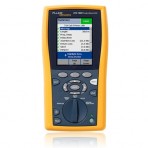Whether installing new cable, or troubleshooting existing cable, cable testing plays an important role in the process. Common tests for datacom cabling include length, wiremap, attenuation, NEXT, DC loop resistance, and return loss. As networks evolve, so do the requirements of the cabling infrastructure to support them. New standards are continuously being developed to provide guidelines for cabling professionals when installing, testing, troubleshooting, and certifying both copper and fiber. Whether it’s 10BASE-T, 100BASE-TX or 1000BASE-T, there are specific requirements and potential pitfalls in implementing these technologies. And with the introduction of 10GBASE-T, it becomes even more critical to keep current with the latest developments in cabling and cable testing. Cable testing provides a level of assurance that the installed cabling links provide the desired transmission capability to support the data communication desired by the users. Certification instruments are the only tools that provide “Pass” or “Fail” information in accordance with industry standards. In the North America market, the prevalent industry standards organization dealing with structured cabling, specifically with the transmission capabilities of structured cabling, is the Telecommunications Industry Association (TIA). In the international markets, the Electro-technical commission of the International Organization for Standards (ISO/IEC) creates and maintains standards for telecommunication ...
Archives
Tag Archive for: ‘repair’

